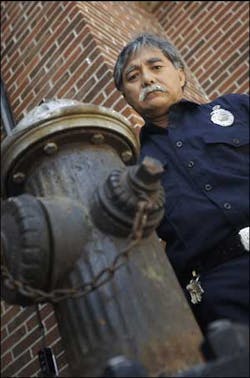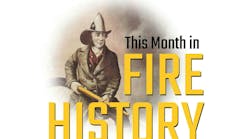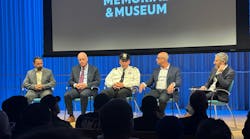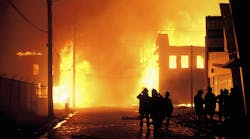The hydrant was a token of appreciation and brotherhood from the California station's sister battalion near Ground Zero.
Cerritos, Calif.-- There's a piece of downtown Manhattan at Los Angeles County Fire Station No. 30 in Cerritos - but it won't just stand as a reminder of the nation's darkest day in the 21st century.
A dry-barrel fire hydrant retrieved from the rubble of the World Trade Center today will make its first public appearance at Sept. 11 memorial events in Artesia and the East San Gabriel Valley. Nearly incinerated by the subsequent fires and thundering collapse of Building 7 - a 50-story structure at Tower One - LACO Fire Captain Joe Woyjeck hopes the 200-pound steel hydrant will come to represent something more profound.
"It's like touching a prayer," said Woyjeck, who also serves as president of the Los Angeles County Fire Museum Association, as he rubbed the hydrant's brass stem top.
The hydrant arrived last Thursday from the New York Fire Department, a token of appreciation and brotherhood from Station 30's sister battalion near Ground Zero. The hydrant has since been mounted on a 250-pound water main stand, a portable exhibit destined to travel between stations and to public events.
Its travel will end once the LACO's fire museum is completed, in an FDNY exhibit wing containing written and photographic accounts of Sept. 11.
Like many firefighter departments across the nation, Los Angeles County Fire dispatched contingents of its own to assist with clean-up and memorial services in the aftermath of Sept. 11.
But there was and continues to be a special connection between Station 30's Battalion 9 and FDNY Battalion 9, said Firefighter Specialist Robert Watanabe.
Highly specialized to fight high-rise blazes, FDNY Battalion 9 was the first to arrive at the scene with all their men and equipment. Except for one firefighter - blown off his feet and buried under the rubble, alive despite a broken neck - everyone in the battalion died at the scene, among the 343 firefighters and paramedics lost that day.
"When we heard about that, none of us could speak," Watanabe said. "We were breathless."
Survivor's guilt
About 20 from Station 30 were among 100 Los Angeles County firefighters who arrived in New York almost a month after the fall of the World Trade Center, flown across the country by an anonymous individual who donated chartered flights on private jets to firefighters in Southern California, Watanabe said.
They weren't asked to dig. They were asked to attend funerals for dead firefighters, whose memorial ceremonies are traditionally attended by uniformed comrades. The surviving firefighters couldn't attend the services, their numbers diverted toward rescue and clean-up.
In addition to the trauma, survivors also carried two griefs, Watanabe said.
"One of the things you learned was that the survivors had survivor's guilt," he said. "They felt guilty they couldn't find more of their own, guilty that they couldn't attend the services."
Los Angeles County fire's contingent attended six funeral services during their weeklong visit.
Another group returned in March 2002 in time for the St. Patrick's Day parade. The event was an opportunity for FDNY and other first-responder agencies to thank the public for their support, Watanabe said. About 250 Los Angeles County firefighters attended as spectators, and were saluted on by FDNY counterparts - many of them rookies, hired post-9/11 - on the route.
The March visit connected Watanabe's group to a Brooklyn station, whose crew invited him and several others to visit what remained of the World Trade Center.
While on scene, Watanabe and his hosts received a grim surprise: while cleaning up, firefighters uncovered one of their own. It took 45 crew members to disentangle FDNY Firefighter John Collins from the wreckage.
`My door is always open'
The visceral experience of retrieving Collins' body inspired Watanabe to embark on a project still in progress today.
The 9-11 Memorial Flag Case Project evolved from an article Watanabe read in a woodworking magazine spotlighting the efforts of National Organizer of Woodworkers United for America to honor the surviving families of Sept. 11 victims. He contacted the organization to express interest in participating and a request to give one of the hand-made cases to Collins' family.
Collins' case - a handsome, black walnut triangular box housing a folded American flag - took 25 hours to complete. Interests for the case increased, and Watanabe soon found himself fielding requests from FDNY firefighters for more.
"Whatever we did as individuals is nothing really special when you think about how much many others have done," Watanabe said. "It's hard to explain. Firefighters don't sit around. We do poorly sitting around."
To date, more than 50 have been delivered to FDNY stations for firefighters to present to 9/11 families. The encased flags were flown over the capitol courtesy of Congressman Dana Rohrabacher, R-Huntington Beach/Long Beach, Watanabe said. The project was made possible with sponsorship from the County of Los Angeles Fire Museum Association, Los Angeles County Firefighter's Association and members of the Los Angeles County Fire Department.
Friendships were formed in the aftermath of Sept. 11, Woyjeck said, adding that NYFD firefighters and their families have visited Los Angeles County firefighters.
The doors remain open today, Woyjeck added. Collins' family remains in touch with Watanabe, with whom they vacationed after losing their son, a man known to anonymously leave groceries and toys at the doorsteps of Brooklyn's poor families every Christmas.
In a condolence book presented to FDNY during Los Angeles County Fire's first visit in October 2001, several handwritten notes from local and overseas firefighters invited communication by offering phone numbers, e-mail addresses and home addresses.
"My door is always open," wrote Capt. Thomas Dutton, "please stop by."
"Call anytime," wrote Firefighter Timothy Brun in his postscript, "God Bless."
"Firefighters all over the world are like a family and we all lost a part of that family," wrote Detlef Maushaue, a firefighter from Germany's Salzgitter Fire Department riding with Station 30. "Our thoughts and prayers are with you. Please feel free to drop me an e-mail anytime or stop by. There'll be a space for you."
For information on the FDNY fire hydrant, log on to www.clafma.org.
Samantha Gonzaga can be reached at [email protected] or (562) 499-1284.
Courtesy of the Long Beach Press-Telegram.






